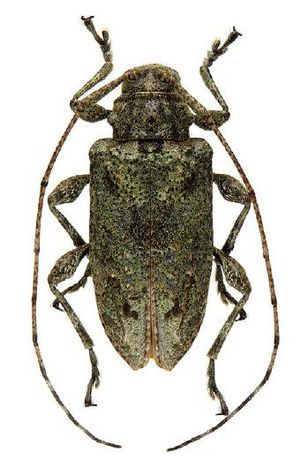Leptostylopsis chlorescens facts for kids
Quick facts for kids Leptostylopsis chlorescens |
|
|---|---|
 |
|
| Scientific classification | |
| Kingdom: | |
| Phylum: | |
| Class: | |
| Order: | |
| Family: | |
| Subfamily: |
Lamiinae
|
| Genus: |
Leptostylopsis
|
| Species: |
L. chlorescens
|
| Binomial name | |
| Leptostylopsis chlorescens Lingafelter & Micheli, 2009
|
|
Leptostylopsis chlorescens is a fascinating type of longhorn beetle. These beetles are part of a large group called the Lamiinae subfamily. Scientists Lingafelter and Micheli first officially described this specific beetle in 2009. Like all longhorn beetles, Leptostylopsis chlorescens has very long antennae, which can sometimes be even longer than its body!
Contents
What is a Longhorn Beetle?
Longhorn beetles are a big family of insects known as Cerambycidae. There are over 35,000 different kinds of longhorn beetles found all over the world. They get their name from their very long antennae. These antennae are often curved, like the horns of some animals.
Amazing Antennae
The long antennae of these beetles are not just for show. They are super important sensory organs. Beetles use their antennae to feel their way around, smell food, and even find other beetles. Some male beetles have antennae that are much longer than their own bodies!
Where Do They Live?
Longhorn beetles live in many different places around the globe. You can find them in forests, woodlands, and even in your backyard. They often live near trees because many species depend on wood for food and shelter. Some types prefer living in dead or decaying wood, while others live in healthy trees.
What Do They Eat?
The diet of longhorn beetles changes depending on their age. Young beetles, called larvae, usually eat wood. They tunnel through the wood of trees, both living and dead. This can sometimes cause damage to trees. Adult longhorn beetles often eat different things. Some drink nectar from flowers, while others might munch on leaves or bark. The specific diet of Leptostylopsis chlorescens is similar to other beetles in its group, likely involving wood during its larval stage.
Life Cycle of a Beetle
Like many insects, longhorn beetles go through a complete metamorphosis. This means they change a lot as they grow. Their life cycle has four main stages: egg, larva, pupa, and adult.
From Egg to Adult
The life of a longhorn beetle starts when a female beetle lays her tiny eggs. She usually places them in cracks in tree bark or in decaying wood. Once the eggs hatch, a larva emerges. This larva is often a pale, worm-like creature with strong jaws. It spends most of its time tunneling and eating wood. This stage can last for months or even years.
After growing enough, the larva changes into a pupa. The pupa is a resting stage where the beetle transforms. It doesn't eat or move much. Inside the pupa, the larva's body rearranges itself into the adult form. Finally, the adult beetle breaks out of the pupal case. The adult beetle's main job is to find a mate and lay eggs, starting the cycle all over again.
Why Are Beetles Important?
Longhorn beetles play an important role in nature. When their larvae tunnel through dead or dying wood, they help break it down. This process returns nutrients to the soil, which helps new plants grow. They are also a food source for birds and other animals. Some species can be pests if they damage valuable trees, but overall, they are a natural part of many ecosystems.
Discovery of Leptostylopsis chlorescens
Leptostylopsis chlorescens was officially named in 2009 by two scientists, Lingafelter and Micheli. Discovering and naming new species is an important part of biology. It helps us understand the amazing variety of life on Earth. Each new species adds to our knowledge of insects and their habitats.
See Also
 In Spanish: Leptostylopsis chlorescens para niños
In Spanish: Leptostylopsis chlorescens para niños

